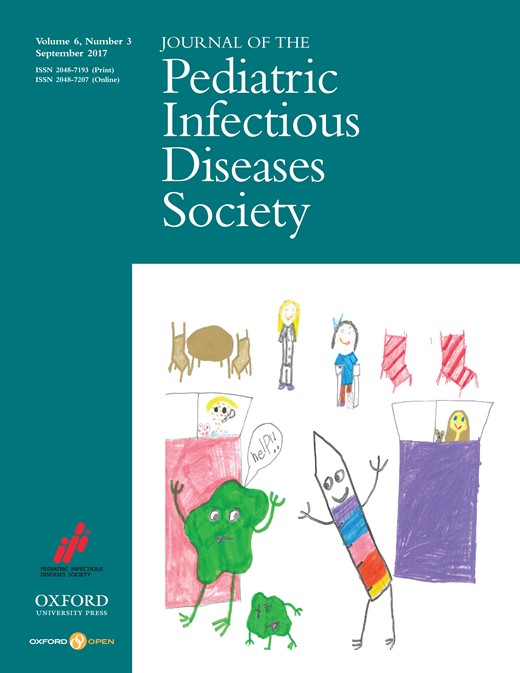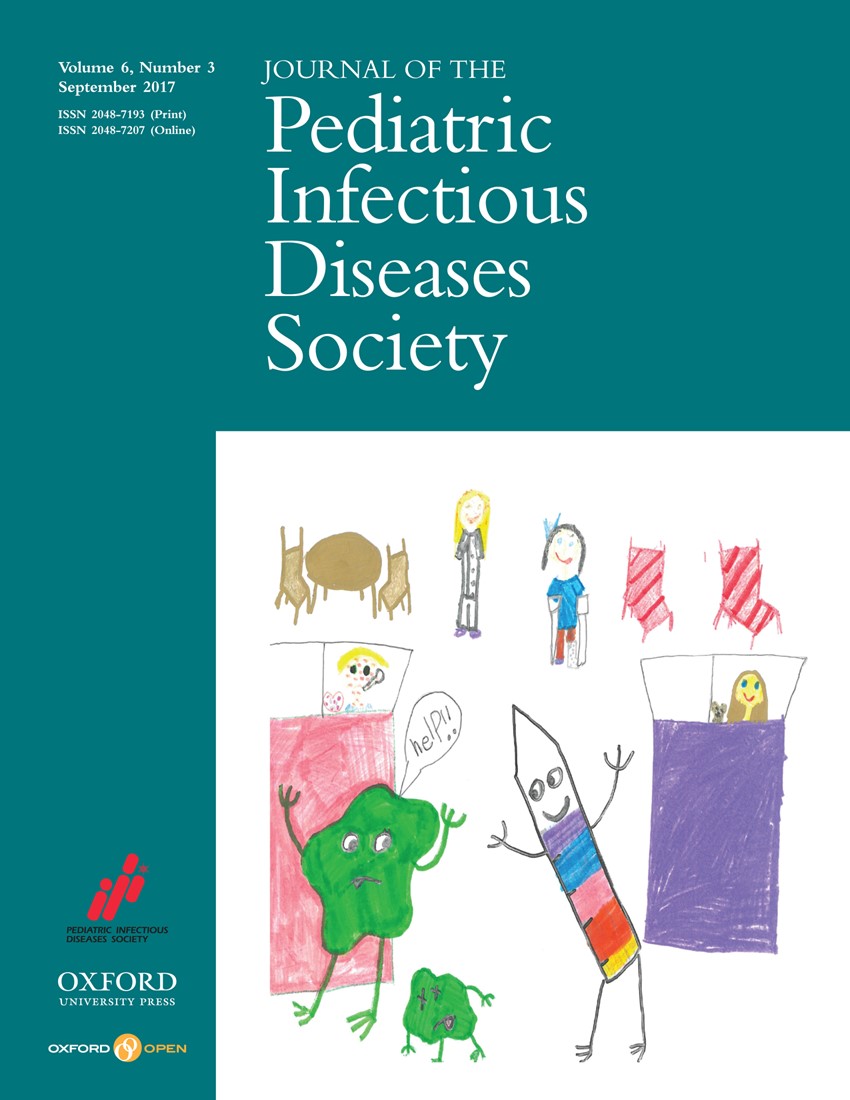
Cover image

Volume 6, Issue 3, September 2017
ACIP UPDATE
Update From the Advisory Committee on Immunization Practices
The ACIP adopted new language regarding revaccination of infants born to HBsAg-positive mothers who are unprotected with the initial vaccination series to indicate that these infants now should receive 1 additional dose (rather than 3), followed by retesting.
The majority of circulating influenza strains are Influenza A, and of those, the vast majority are H3N2 viruses; current influenza vaccines are well matched to circulating strains, with an interim vaccine efficacy of 48%, which is fairly typical for H3N2-predominant seasons
ORIGINAL ARTICLES
Colonization With Antimicrobial-Resistant Gram-Negative Bacilli at Neonatal Intensive Care Unit Discharge
In multivariable analysis, prolonged antimicrobial treatment was a predictor of infant colonization with antimicrobial-resistant Gram-negative bacilli within 7 days of discharge from a neonatal intensive care unit.
Gram-Negative Bacilli in Infants Hospitalized in The Neonatal Intensive Care Unit
In this study, Gram-negative bacilli that cause infections had variable rates of gentamicin resistance among different neonatal intensive care units, whereas the rates of carbapenem resistance were low.
Detection of 23 Gastrointestinal Pathogens Among Children Who Present With Diarrhea
In the era of widespread rotavirus vaccine use, toxigenic Clostridium difficile, diarrheagenic Escherichia coli, and viruses (particularly norovirus) are commonly detected among children with infectious gastroenteritis in the United States by using a multipathogen molecular panel.
Measles Outbreak in a Child Care Center, Cook County, Illinois, 2015
High Viremia and Wasting Before Antiretroviral Therapy Are Associated With Pneumonia in Early-Treated HIV-Infected Kenyan Infants
The Effect of 13-Valent Pneumococcal Conjugate Vaccine on the Serotype Distribution and Antibiotic Resistance Profiles in Children With Invasive Pneumococcal Disease
Viral Etiology and the Impact of Codetection in Young Children Presenting With Influenza-Like Illness
Children frequently had multiple respiratory viruses detected. Although common, children with multiple viruses more frequently had cough and rhinorrhea. Children with influenza and respiratory syncytial virus were hospitalized most frequently. Routine screening and cohorting are recommended only for those with common respiratory pathogens.
Clinical Impact and Provider Acceptability of Real-Time Antimicrobial Stewardship Decision Support for Rapid Diagnostics in Children With Positive Blood Culture Results
Real-time antimicrobial stewardship decision support for rapid blood culture diagnostics is associated with improved times to optimal and effective antimicrobial therapies and decreased unnecessary antimicrobial use in children. The unsolicited intervention incorporated with result reporting was well accepted and resulted in high provider satisfaction.
Epidemiology of Diarrheal Illness in Pediatric Oncology Patients
Non–Type b Haemophilus influenzae Invasive Infections in North Dakota and South Dakota, 2013–2015
Misclassification of Antiretroviral Treatment Failure Using WHO 2006 and 2010/2013 Immunologic Criteria in HIV-Infected Children and Adolescents in Western Kenya
LITERATURE REVIEW
Defining Pediatric Diarrhea in Low-Resource Settings
BRIEF REPORTS
Pharmacokinetics of Darunavir/Ritonavir With Etravirine Both Twice Daily in Human Immunodeficiency Virus-Infected Adolescents and Young Adults
Evaluation of the New World Health Organization Case Definition of Severe Acute Respiratory Infection for Influenza Surveillance During the Peak Weeks of Two Influenza Seasons in Quebec, Canada
Trainee Needs in Pediatric Transplant Infectious Diseases Education
PEDIATRIC ID CONSULTANT
Gradenigo Syndrome and Cavitary Lung Lesions in a 5-Year-Old With Recurrent Otitis Media
LETTER TO THE EDITOR
Four Component Meningococcal Capsular Group B Vaccine in Preterm Infants
ELECTRONIC ARTICLES
ORIGINAL ARTICLES
Assessing Fever Frequency After Pediatric Live Attenuated Versus Inactivated Influenza Vaccination
The frequencies of fever in young children after live attenuated influenza versus inactivated influenza vaccine were low during the 2013–2014 influenza season and did not differ among vaccine types. Results from text message–only data were similar to those from all sources.
Evaluation of Commercial Assays for Single-Point Diagnosis of Pertussis in the US
Sexually Transmitted Infections in Youth With Controlled and Uncontrolled Human Immunodeficiency Virus Infection
Prevalence, Characteristics, and Perception of Nursery Antibiotic Stewardship Coverage in the United States
Impact of an Antimicrobial Stewardship Program on Antibiotic Use at a Nonfreestanding Children’s Hospital
High Postdischarge Morbidity in Ugandan Children With Severe Malarial Anemia or Cerebral Malaria
Postdischarge readmission and outpatient illnesses are frequent in children with severe malarial anemia or cerebral malaria. Trials of postdischarge malaria prophylaxis in children with severe malaria should be considered.
Case-Control Assessment of the Roles of Noroviruses, Human Bocaviruses 2, 3, and 4, and Novel Polyomaviruses and Astroviruses in Acute Childhood Diarrhea
By expanding a case-control specimen-set analysis to include polymerase chain reaction for noroviruses, novel astroviruses, human bocaviruses, and Malawi and St. Louis polyomaviruses, we found a definite or plausible pathogen in 79% of case stools.
Geographic Disparities in Cytomegalovirus Infection During Pregnancy
High Reported Rates of Antimicrobial Resistance in Indian Neonatal and Pediatric Blood Stream Infections
Immunogenicity of a Booster Dose of Quadrivalent Meningococcal Conjugate Vaccine in Previously Immunized HIV-Infected Children and Youth
Pathogen-Specific Burden of Outpatient Diarrhea in Infants in Nepal: A Multisite Prospective Case-Control Study
Clinical Care Guideline for Improving Pediatric Acute Musculoskeletal Infection Outcomes
Allograft Inflammatory Factor-1 Links T-Cell Activation, Interferon Response, and Macrophage Activation in Chronic Kawasaki Disease Arteritis
Association of Vancomycin Trough Concentration With Response to Treatment for Acute Pulmonary Exacerbation of Cystic Fibrosis
The majority of patients experienced improvement in pulmonary function and a return to their baseline forced expiratory volume in 1 second while achieving a vancomycin trough concentration in the range of 10 to <15 µg/mL. No correlation between markers of vancomycin exposure and change in pulmonary function test results were identified.
Hepatic, Renal, Hematologic, and Inflammatory Markers in HIV-Infected Children on Long-term Suppressive Antiretroviral Therapy
Pediatric Dental Clinic–Associated Outbreak of Mycobacterium abscessus Infection
We describe the clinical presentation, management, and medical and surgical outcomes and associated morbidities of 24 school-aged children with invasive odontogenic Mycobacterium abscessus infections that occurred after municipal water exposure during a restorative dental pulpotomy procedure at a pediatric dental practice.
INVITED REVIEW
Fungal Infections of the Central Nervous System in Children
The purpose of this review was to summarize the epidemiology, clinical features, diagnosis, and treatment of the most common pediatric fungal infections of the central nervous system.
BRIEF REPORTS
Non–Type b Haemophilus influenzae Septic Arthritis in Children
Characterization of Children With Recurrent Episodes of Stevens Johnson Syndrome
Infant Colonization With Methicillin-Resistant Staphylococcus aureus or Vancomycin-Resistant Enterococci Preceding Neonatal Intensive Care Unit Discharge
Retrospective Analysis of Posaconazole Suspension Dosing Strategies in a Pediatric Oncology Population: Single-Center Experience
Treatment-Related Complications in Children Hospitalized With Disseminated Lyme Disease
An analysis of 138 patients with disseminated Lyme disease revealed that children who received parenteral therapy had a higher rate of treatment-related complications than those who received oral therapy. Oral therapy should be used when possible to limit treatment-related complications.


